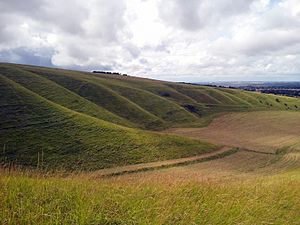Whitehorse Hill facts for kids
| Site of Special Scientific Interest | |
 |
|
| Area of Search | Oxfordshire |
|---|---|
| Interest | Biological Geological |
| Area | 98.9 hectares (244 acres) |
| Notification | 1986 |
| Location map | Magic Map |
Whitehorse Hill is a famous hill in Oxfordshire, England. It is part of the Berkshire Downs and is located west of the town Wantage. Standing at 261 metres (856 ft), it is the highest point in all of Oxfordshire!
This special hill is home to some amazing historical sites. On its very top, you'll find Uffington Castle, an ancient hillfort. And on the northern side of the hill, you can see the famous Uffington White Horse, a giant figure carved into the chalk hillside.
The hill and the area around it, including Dragon Hill and a unique valley called The Manger, are part of a 98.9-hectare (244-acre) area known as a Site of Special Scientific Interest. This means it's a very important place for both nature and geology.
Contents
Discover Whitehorse Hill
Whitehorse Hill is more than just a tall spot. It's a place where history and nature meet. People have lived and visited this area for thousands of years. The hill offers amazing views of the surrounding countryside.
What Makes This Hill Special?
The entire area, including Whitehorse Hill, Dragon Hill, and The Manger, is protected. It's called a Site of Special Scientific Interest (SSSI). This protection helps to keep its unique plants, animals, and geological features safe. The site was officially recognized as an SSSI in 1986.
The Manger: A Geological Wonder
Below Whitehorse Hill, you'll find a dry valley known as The Manger. This valley is a special place for geologists, which are scientists who study the Earth. It's a Geological Conservation Review site because it holds important clues about Earth's past.
The Manger shows signs of something called solifluction. This is a slow movement of soil down a hillside. It happens when the ground freezes and thaws many times. This process happened during a very cold time in Earth's history called the Pleistocene epoch, also known as the Ice Age.
Plants and Nature on the Hill
Whitehorse Hill is covered in a type of grassland called "unimproved chalk grassland." This means the land hasn't been changed much by farming or other human activities. Because of this, it has a wide variety of wild plants, also known as flora.
You can find many different types of grasses here, like upright brome and sheep’s fescue. The old chalk quarries on the hill are especially rich in these diverse plants.
The Ridgeway Trail
A very old path called The Ridgeway National Trail crosses Whitehorse Hill. This ancient trail has been used for thousands of years. Today, people enjoy walking along it to explore the beautiful landscape and history of the area.

